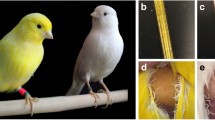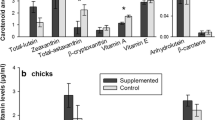Abstract
Allocation trade-offs of carotenoids between their use in the immune system and production of sexual ornaments have been suggested as a proximate mechanism maintaining honesty of sexual signals. To test this idea, we experimentally examined whether carotenoid availability in the diet was related to variation in antibody response to novel antigens in male greenfinches (Carduelis chloris aurantiiventris), a species with extensive carotenoid-dependent plumage colouration. We also measured the cost of mounting a humoral response in terms of circulating carotenoids. Finally, we examined the relationship between plumage colour, immune response and circulating carotenoids. We found that males with carotenoid-supplemented diets showed stronger antibody response than non-supplemented birds. We also found that activation of the immune system significantly reduced circulating carotenoids (24.9% lower in immune-challenged birds than in control birds). Finally, intensity (chroma) of ventral plumage colouration of males, a character directly related to concentration of total carotenoids in feathers, was negatively correlated with the immune response and circulating carotenoids in winter. These results support the idea that carotenoids are a limiting resource and that males trade ornamental colouration against immune response.




Similar content being viewed by others
References
Allen PT (1987) Effect of Eimeria acervulina infection on chick (Gallus domesticus) high density lipoprotein composition. Comp Biochem Physiol 87B:313–319
Allen PT (1992) Effect of coccidiosis on the distribution of dietary lutein in the chick. Poult Sci 71:1457–1463
Alonso-Alvarez C, Bertrand S, Devevey G, Gaillard M, Prost J, Faivre B, Sorci G (2004) An experimental test of the dose-dependent effect of carotenoids and immune activation on sexual signals and antioxidant activity. Am Nat 164:651–659
Amat JA, Aguilera E, Visser GH (2007) Energetic and developmental costs of mounting an immune response in greenfinches (Carduelis chloris). Ecol Res 22:282–287
Andersson M (1994) Sexual selection. Princeton University Press, Princeton
Bendich A (1989) Carotenoids and the immune response. J Nutr 119:112–115
Birkhead TR, Fletcher F, Pellat EJ (1998) Sexual selection in the zebra finch Taeniopygia guttata: condition, sex traits and immune capacity. Behav Ecol Sociobiol 44:179–191
Blount JD, Metcalfe NB, Birkhead TR, Surai PF (2003) Carotenoid modulation of immune function and sexual attractiveness in zebra finch. Science 300:125–127
Boa-Amponsem K, Price SHE, Dunnington EA, Siegel PB (2001) Effect of route of inoculation on humoral immune response of White Leghorn chickens selected for high or low antibody response to sheep red blood cells. Poultry Sci 80:1073–1078
Chew BP (1993) Role of carotenoids in the immune response. J Dairy Sci 76:2804–2811
Cramp S, Perrins CM (1994) The birds of Western Palaearctic, vol VII. Oxford University Press, Oxford
Eley C (1991) Status signalling in the western green finch (Carduelis chloris). Ph.D. thesis, University of Sussex, Brighton, UK
Endler JA (1990) On the measurement and classification of colour in studies of animal colour patterns. Biol J Linn Soc 41:315–352
Evans MR, Goldsmith AR, Norris SRA (2000) The effects of testosterone on antibody production and plumage coloration in male house sparrows (Passer domesticus). Behav Ecol Sociobiol 47:156–163
Faivre B, Gregorie A, Preault M, Cézilly F, Sorci G (2003a) Immune activation rapidly mirrored in a secondary sexual trait. Science 300:103
Faivre B, Preault M, Salvadori F, Thery M, Gaillard M, Cézilly F (2003b) Bill colour and immunocompetence in the European blackbird. Anim Behav 65:1125–1131
Fenoglio S, Cucco M, Malacarne G (2002) The effect of a carotenoid-rich diet on immunocompetence and behavioural performance in moorhen chicks. Ethol Ecol Evol 14:149–156
Figuerola J, Senar JC, Pascual J (1999) The use of colorimeters on free-living birds: sex, age and locality differences in blue tits (Parus caeruleus) coloration. Ardea 87:269–275
Folstad I, Karter AJ (1992) Parasites, bright males and the immunocompetence handicap. Am Nat 139:603–622
Gray DA (1996) Carotenoids and sexual dichromatism in North American passerine birds. Am Nat 148:453–480
Hamilton WD, Zuk M (1982) Heritable true fitness and bright birds: a role for parasites? Science 218:384–387
Higgins DA (1996) Comparative immunology of avian species. In: Davison TF, Morris TR, Payne LN (eds) Poultry immunology. Carfax, Abingdon, pp 149–205
Hill GE (1999a) Mate choice, male quality, and carotenoid-based plumage colouration. In: Adams N, Slowtow R (eds) Proceedings of the 22nd International Ornithological Congress. Durban, pp 1654–1668
Hill GE (1999b) Is there an immunological cost to carotenoid-based ornamental coloration? Am Nat 154:589–595
Koutsos EA, Calvert CC, Klasing KC (2003) The effects of an acute phase response on tissue carotenoid levels of growing chickens (Gallus gallus domesticus). Comp Biochem Physiol 135A:635–646
Kreukniet MB, van der Zijpp AJ, Nieuwland MGB (1992) Effects of route of immunization, adjuvant and unrelated antigens on the humoral immune response in lines of chickens selected for antibody production against sheep erythrocytes. Vet Immunol Immunopathol 33:115–127
Li Z, Nestor KE, Saif YM, Anderson JW (2000) Antibody responses to sheep red blood cell and Brucella abortus antigens in a turkey line selected for increased body weight and its random bred control. Poultry Sci 79:804–809
Lozano GA (1994) Carotenoids, parasites, and sexual selection. Oikos 70:309–311
Lozano GA (2001) Carotenoids, immunity, and sexual selection: comparing apples and oranges? Am Nat 158:200–203
Lynn SE, Houtman AM, Weathers WW, Ketterson ED, Val Nolan JR (2000) Testosterone increases activity but not daily energy expenditure in captive male dark-eyed juncos (Junco hyemalis). Anim Behav 60:581–587
Maynard Smith J, Harper DGC (1988) The evolution of aggression: can selection generate variability? Philos Trans R Soc Lond B Biol Sci 319:557–570
McGraw KJ, Ardia DR (2003) Carotenoids, immunocompetence, and the information content of sexual colors: an experimental test. Am Nat 162:704–712
Møller AP, Petrie M (2002) Condition dependence, multiple sexual signals, and immunocompetence in peacocks. Behav Ecol 13:248–253
Møller AP, Pomiankowski A (1993) Why have birds got multiple sexual ornaments? Behav Ecol Sociobiol 32:167–176
Møller AP, Christe P, Lux E (1999) Parasitism, host immune function, and sexual selection. Q Rev Biol 74:3–20
Møller AP, Biard C, Blount JD, Houston DC, Ninni P, Saino N, Surai PF (2000) Carotenoid-dependent signals: indicators of foraging efficiency, immunocompetence or detoxification ability? Avian Poult Biol Rev 11:137–159
Munns PL, Lamont SJ (1991) Effects of age and immunization interval on anamnestic response to T-cell-dependent and T-cell-independent antigens in chickens. Poultry Sci 70:2371–2374
Navara KJ, Hill GE (2003) Dietary carotenoid pigments and immune function in a songbird with extensive carotenoid-based plumage coloration. Behav Ecol 14:909–916
Olson VA, Owens IPF (1998) Costly sexual signals: are carotenoids rare, risky or required. Trends Ecol Evol 13:510–514
Saks L, McGraw K, Hõrak P (2003a) How feather colour reflects its carotenoid content. Funct Ecol 17:555–561
Saks L, Ots I, Hõrak P (2003b) Carotenoid-based plumage coloration of male greenfinches reflects health and immunocompetence. Oecologia 134:301–307
Senar JC, Polo V, Uribe F, Camerino M (2000) Status signalling, metabolic rate and body mass in the siskin: the costs of being subordinate. Anim Behav 59:103–110
Stradi R, Celentano G, Rossi E, Rovati G, Pastore M (1995) Carotenoids in bird plumage. I. The carotenoid pattern in a series of Palearctic Carduelinae. Comp Biochem Physiol 110B:131–143
Tella JL, Negro JJ, Rodríguez-Estrella R, Blanco G, Forero MG, Blázquez MC, Hiraldo F (1998) A comparison of spectrophotometry and color charts for evaluating total plasma carotenoids in wild birds. Physiol Zool 71:708–711
von Schantz T, Bensch S, Grahn M, Hasselquist D, Wittzell H (1999) Good genes, oxidative stress and condition-dependent sexual signals. Proc R Soc Lond B Biol Sci 266:1–12
Wedekind C (1992) Detailed information about parasites revealed by sexual ornamentation. Proc R Soc Lond B Biol Sci 247:169–174
Wedekind C, Folstad I (1994) Adaptive or nonadaptive immunosuppression by sex hormones? Am Nat 143:936–938
Wegmann TG, Smithies O (1966) A simple hemagglutination system requiring small amounts of red cells and antibodies. Transfusion 6:67–73
Westneat DF, Birkhead TR (1998) Alternative hypotheses linking the immune system and mate choice for good genes. Proc R Soc Lond B Biol Sci 265:1065–1073
Wingfield JC, Hegner RE, Dufty AM, Ball GF (1990) The “challenge hypothesis”—theoretical implications for patterns of testosterone secretion, mating systems and breeding strategies. Am Nat 136:829–846
Acknowledgements
We thank Manolo Vázquez, Rocío Ruiz, María López and Nico Varo for assistance with trapping and taking care of birds, María José Torres for laboratory training and Tomás Redondo, Jordi Figuerola, Kevin McGraw and three anonymous referees for constructive criticisms on an earlier version of the manuscript. Financial support was provided by the Spanish DGESIC (project PB98-0494-C02-01).
Author information
Authors and Affiliations
Corresponding author
Rights and permissions
About this article
Cite this article
Aguilera, E., Amat, J.A. Carotenoids, immune response and the expression of sexual ornaments in male greenfinches (Carduelis chloris). Naturwissenschaften 94, 895–902 (2007). https://doi.org/10.1007/s00114-007-0268-5
Received:
Revised:
Accepted:
Published:
Issue Date:
DOI: https://doi.org/10.1007/s00114-007-0268-5




